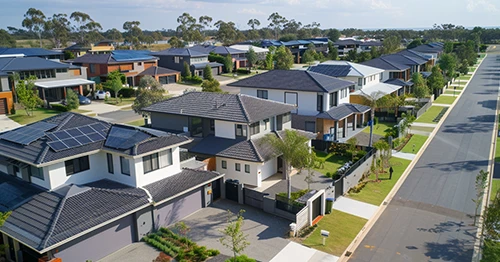Updated: 27 Dec, 2024
CoreLogic’s Home Value Index recorded a 0.9% rise in October 2023. The national index has bounced back 7.6% and is merely half a percentage point shy of the historic highs witnessed in April last year.
CoreLogic’s research director, Tim Lawless, said that a nominal recovery in the national index could happen soon. “At this rate of growth, we will see the national HVI reach a record high midway through November, recovering from the 7.5% drop in values recorded over the recent downturn between May 2022 and January 2023.”
Regional markets across Australia trailed their capital city counterparts, with a combined regional lift in the regional index of 0.7% in October, compared with a 0.9% rise in combined capitals. The trend of higher growth in capitals is noticeable across every state. Regional Queensland, WA, and SA demonstrated robust conditions, with record-high values in October. Regional Victoria was the softest of the regional areas, with values holding nearly flat (-0.2%) over the last quarter and lagging 7.2% behind the May 2022 peak.
Slowdown In Growth
Despite the consistent upward trajectory in housing values across most capital cities, there was a noticeable slowdown in the pace of growth. In the three months ending June 2023, capital city values rose by 3.7%, but this growth trend gradually tapered off to 2.6% over the three months ending October 2023.
Lawless explained, “The slower rate of appreciation can probably be attributed to a combination of higher advertised stock levels and stretched affordability. With an acceleration in the flow of new listings coming onto the market, it’s unlikely buyer demand will be able to keep pace as we move through the spring amid high interest rates and low sentiment.”
Property Market Highlights
Here’s what happened in Australia’s property market in October 2023:
- After 10 months of below-average vendor activity, new capital listings surged in winter and spring, now standing at nearly 12% higher than a year ago. However, total listings were lower than the previous year.
- The balance of advertised stock varied across the country. In Perth, stock levels fell through spring to be 2.1% below the levels recorded in winter. Listing numbers in Brisbane and Adelaide remained steady, with a 0.5% and 1.6% increase, respectively. However, the ACT experienced a surge in listings, marking an impressive 21.3% increase during the spring-to-date period. Melbourne and Sydney experienced a boost in total listings, with a 10.7% rise in Melbourne and a 9.3% increase in Sydney.
- Rental vacancies were at a record low. They reached 0.9% across combined capitals and 1.2% across combined regional markets.
- Nationally, rental listings were 35.5% below the previous five-year average over the four weeks ending 29 October. This was 16.1% lower than a year ago.
- Despite the tight rental supply, rental growth rates were more diverse. The rolling quarterly rate of rental growth in combined capitals decreased from 3.1% over the three months ending May, to 1.8% in the most recent three-month period.
- House rents have been rising faster than unit rents in Sydney and Melbourne, which can be attributed to the seasonality of university semesters and foreign student arrivals. Perth experienced the highest annual growth, with a rise of 12.7% in house rents and 16.6% in unit rents over the past year.
- Gross rental yields peaked, but values continue to rise, and the rate of rental growth is decelerating. Nationally, gross yields hit their peak between February and April, at 3.73%, and gradually fell, to reach 3.69% in October.
- The auction clearance rate fell from the low 70% range in May to the mid-60% range in October.
Housing Market Outlook
While the housing market has shown resilience, the outlook isn’t as positive as it was a few months ago. This is due to various factors, including low sentiment, stretched affordability, and the potential for another interest rate hike.
- The low supply that has characterised the market for some time is slowly shifting, with new listings outpacing active buyers, which may favour buyers.
- Consumer sentiment is pessimistic, and it has a historical connection with housing activity. As such, a further drop in consumer spirits could lead to reduced buyer activity.
- Mortgage repayments have increased, further impacting the market dynamics. Mortgage repayments on $500,000 home loans have increased by about $1,040 a month since the first rate hike in May 2022. Another 25-basis-point rate hike would add about $81 more a month.
- There is a potential for a reduction in the rate of growth in housing values, alongside noticeable diversity in capital city growth performance. There already is a taper in the pace of growth in Sydney and Melbourne. The slowdown came amid higher advertised stock levels and stretched affordability.
- Perth, Brisbane and Adelaide appear to be more resilient in the face of supply shortages and affordability challenges. These cities benefit from positive interstate migration trends, which offer more direct support to purchasing demand compared to overseas migration.
Several factors continue to underpin demand and property values in the housing market:
- Low Unemployment: With expectations of unemployment remaining well below the long-term average, the risk of mortgage defaults or distressed home sales is likely to stay at bay.
- Under Supply: The persistent under-supply of housing may exert upward pressure on property prices over the medium term, sustaining the market’s buoyancy.
- Rental Market Influence: The tight rental market may lead to a spillover effect, where high rental demand could potentially translate into increased demand for property purchases. This dynamic reflects the evolving landscape of the Australian housing market.





